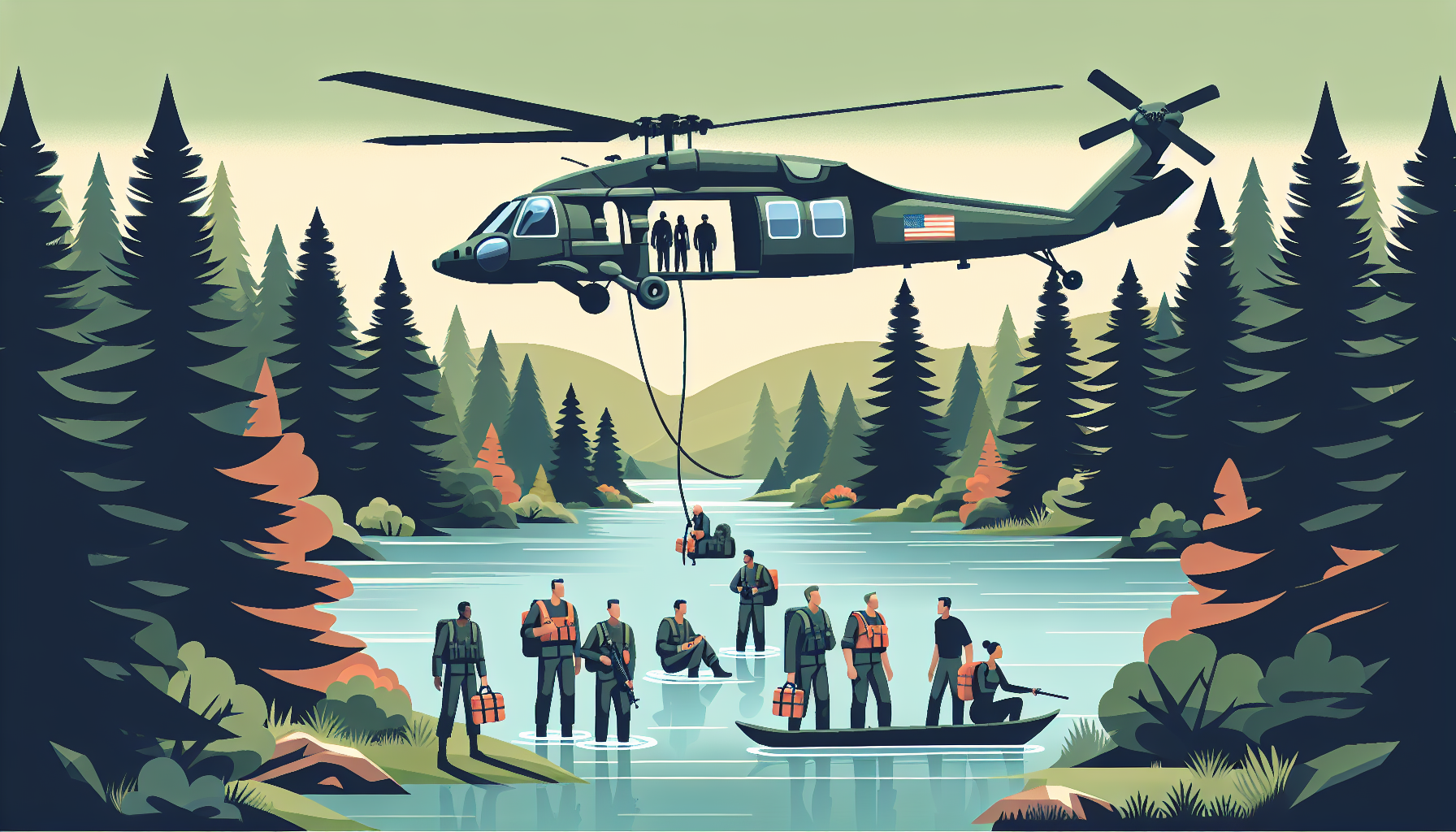Definition
Combat search and rescue (CSAR) is a specialized type of military operation that focuses on the recovery and extraction of combatants who are isolated, missing, or in distress. These missions often involve the use of specialized personnel, aircraft, and equipment designed to locate and retrieve individuals in hostile or dangerous environments. CSAR operations prioritize the quick and safe recovery of personnel while minimizing the risk to both the rescue team and the individual being rescued.
Key Takeaways
- Combat search and rescue (CSAR) is a specialized military operation conducted to recover isolated personnel, such as downed pilots or captured soldiers, in hostile territory.
- CSAR operations require highly trained personnel, advanced equipment, and exceptional coordination among various armed forces units, with assets typically including helicopters, fixed-wing aircraft, and special operations forces.
- The primary objectives of CSAR missions are to ensure the safe return of isolated personnel to friendly control, to protect them from capture or harm, and to deny adversaries any potential intelligence, propaganda, or strategic gains from capturing personnel.
Importance
Combat Search and Rescue (CSAR) is a crucial aspect of military operations because it involves the timely and efficient recovery of downed aircrew, isolated personnel, or stranded soldiers from hostile or denied areas.
CSAR is essential for maintaining high morale and trust among military personnel, as it showcases an unwavering commitment to leave no one behind in enemy territory.
By employing highly trained, well-equipped, and coordinated units for these critical missions, the armed forces can ensure the safe return of their personnel while minimizing additional casualties.
Furthermore, successful CSAR missions can protect vital intelligence, equipment, and resources from falling into the hands of the enemy.
Overall, CSAR operations play a significant role in safeguarding the well-being of military personnel and maintaining the operational readiness and effectiveness of the armed forces.
Explanation
Combat search and rescue (CSAR) serves a vital purpose in military operations by locating and recovering downed pilots, ground troops, and other personnel who become isolated or trapped in hostile territory. CSAR operations are not solely limited to recovering wounded or distressed individuals but also extend to retrieving sensitive equipment to prevent it from falling into enemy hands.
These highly trained and specialized units assume extraordinary risks, operating in dangerous environments where threats from enemy forces are prevalent. The success of a CSAR mission can significantly impact morale and foster a strong sense of allegiance among military personnel knowing that they will not be left behind when in trouble.
To execute a CSAR mission effectively, a harmonious fusion of intelligence, air and ground forces, and careful planning is essential. This often includes the utilization of reconnaissance assets to first locate the missing or trapped individuals, followed by the deployment of swift and stealthy recovery teams who possess expert knowledge in navigation, evasion techniques, and extraction under extreme conditions.
These missions can be prolonged due to the complex nature of hostile territories and require appropriate support from additional forces that provide air cover, medical care, and contribute to the overall success of the operation. Ultimately, the primary goal of combat search and rescue is to reunite the recovered military personnel with friendly forces, ensuring their safety and further strengthening the combat effectiveness and resolve of the military.
Examples of Combat search and rescue (CSAR)
Operation Kingpin (1970): A notable CSAR mission during the Vietnam War was the Son Tay prison raid, also known as Operation Kingpin. The mission aimed to rescue American prisoners of war held at a camp near Hanoi in North Vietnam. U.S. Special Forces and aircrews executed a daring nighttime raid, but upon arrival, they discovered that the prisoners had been relocated. Despite the mission’s failure to recover POWs, it showcased the effectiveness of the CSAR concept, as the raid successfully penetrated deep into enemy territory without significant loss of U.S. personnel or equipment.
Operation Anaconda (2002): During the early stages of the War in Afghanistan, a U.S. Navy SEAL team was tasked with conducting reconnaissance in the Shahi-Kot Valley as part of Operation Anaconda. The team encountered an ambush by Taliban forces and was cut off from their helicopter extraction. A CSAR mission was launched by U.S. Air Force Pave Hawk helicopters to rescue the SEAL team. Two helicopters were shot down during the attempted rescue, leading to further efforts by U.S. and Coalition forces to safely recover the downed aircrews and the original SEAL team. During the resulting battle, the concept of CSAR was demonstrated as multiple personnel were ultimately rescued from hostile territory.
Operation Red Wings (2005): Another significant CSAR operation from the War in Afghanistan was the one launched following the events of Operation Red Wings. In June 2005, a four-man Navy SEAL team was inserted into the mountains of Afghanistan to capture or kill a high-ranking enemy leader. They were discovered and engaged by a large hostile force, leading to the deaths of three of the SEALs. As reinforcements were deployed to the area to assist, one of the rescue helicopters, a U.S. Army Chinook, was shot down by an enemy RPG, killing 16 personnel onboard. Despite further loss and significant setbacks, a dedicated CSAR effort was organized to find and rescue the lone surviving SEAL, Marcus Luttrell. Ultimately, the mission was successful, demonstrating the commitment to the CSAR principle of leaving no one behind.
FAQ: Combat Search and Rescue (CSAR)
What is Combat Search and Rescue (CSAR)?
Combat Search and Rescue (CSAR) is a specialized and important operation within the military. Its primary purpose is to rescue downed aircrew and isolated personnel behind enemy lines, as well as assist in retrieving equipment and any sensitive information that might be lost during a mission. CSAR teams are trained to operate in high-threat environments and utilize various tactics to ensure the safe and successful retrieval of personnel and equipment.
Why is CSAR important?
CSAR is crucial for various reasons. Firstly, it helps in the recovery of aircrew members or other personnel who are stranded in hostile areas. This not only saves the lives of valuable military personnel but also prevents the possibility of sensitive information falling into enemy hands. Second, CSAR helps maintain morale within deployed units, as members know that a skilled team is ready to assist them if necessary. Finally, CSAR serves as a deterrent to enemy forces, indicating that any attempts to capture military personnel would be met with a swift and powerful response.
What is the difference between CSAR and other search and rescue operations?
Although CSAR falls under the broader umbrella of search and rescue (SAR), it differs significantly from other SAR missions. CSAR specifically deals with rescuing personnel behind enemy lines or in hostile territories and requires specialized training and equipment. CSAR forces need to be adept at evading enemy detection or actively engaging enemy forces while they carry out their mission. On the other hand, general SAR operations focus on rescuing individuals in non-hostile environments, such as lost hikers or individuals stranded due to natural disasters.
What types of personnel and equipment are involved in CSAR missions?
CSAR missions require highly skilled and specially trained personnel, such as Pararescue Jumpers (PJs), Combat Controllers (CCTs), and Combat Rescue Officers (CROs). These individuals possess a unique combination of skills, such as medical expertise, air traffic control, and advanced combat capabilities. CSAR personnel are typically supported by a range of specialized equipment and vehicles, including but not limited to helicopters (e.g. HH-60 Pave Hawk), aircraft (e.g. HC-130J), and ground vehicles. Technology such as night vision goggles and advanced communication systems also play a critical role in the success of CSAR missions.
How do CSAR teams coordinate with other military units?
Successful CSAR missions require close coordination and support from various military entities. The CSAR team may work together with intelligence, surveillance, and reconnaissance (ISR) assets to gather valuable information about the mission area beforehand. Additionally, air and ground forces may provide coverage or engage enemy targets to create a safer environment for the CSAR team to perform its rescue operation. Close communication between all involved units is vital to ensure a successful and timely rescue mission.
Related Military Operation Terms
- Airborne rescue operations
- Pararescue teams
- Evasion and recovery
- Downed pilot extraction
- Hostile environment recovery
Sources for More Information
- United States Air Force (USAF): The official homepage of the United States Air Force, which features detailed information about various military operations and tactics, including Combat Search and Rescue (CSAR).
- North Atlantic Treaty Organization (NATO): The NATO website provides extensive information on the alliance’s military operations and strategies, including CSAR missions during joint operations.
- United States Army: The official homepage of the United States Army, another reliable source for information about various military operations, including CSAR and its related tactics and procedures.
- GlobalSecurity.org: An independent organization that offers an extensive collection of information and analysis on various military, security, and defense topics, including detailed articles and resources on CSAR.
 Benefits.com Advisors
Benefits.com Advisors
With expertise spanning local, state, and federal benefit programs, our team is dedicated to guiding individuals towards the perfect program tailored to their unique circumstances.
Rise to the top with Peak Benefits!
Join our Peak Benefits Newsletter for the latest news, resources, and offers on all things government benefits.





















